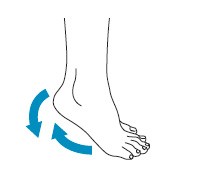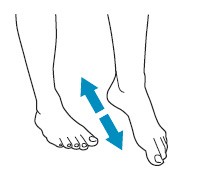

Prevent economy class syndrome – have a safe trip with Juzo travel compression stockings
A dream hotel, impressive places, great food, interesting people – you hear that a lot when travellers tell you about their holidays or business trips. However, nobody talks much about the journey to the destination or back home. No mention of crowds or traffic jams, sitting down for long periods, limited space, tense muscles and painful legs. On journeys to far-away destinations, whether by plane, car, train or bus, the body often reacts with warning signs. Find out how to prevent health risks such as traveller’s thrombosis. We have collected a large amount of information and practical tips that can make long flights and journeys easier for you – on holidays as well as business trips.
Long journeys and the consequences
- The upsides of travelling – further and for longer
- The downsides of travelling – the drawbacks of many dream trips
- Traveller’s thrombosis – how does it develop?
- Traveller’s thrombosis – symptoms and what you should look out for
- Prevent traveller’s thrombosis – optimal prevention with compression
- Compression stocking or support stocking – what is the difference?
- Put them on first and then check in – travel compression stockings for her & him
- How can I prevent traveller’s thrombosis? – tips for the journey
- Travel exercises for confined spaces
- Tips for more comfort and well-being on holidays and business trips
The upsides of travelling – further and for longer
Travellers are drawn out into the world. But neighbouring countries are also very popular.
These days, it’s completely normal for holiday-makers to fly to the US, Mexico, Cuba, Thailand, Bali, Hong Kong – even to places like Dubai just to go shopping.Business travellers are just as likely to find themselves in China, South America or India for work. Even within Europe, the urge to travel remains strong.
Efficient transport connections and familiar local structures make it easy to travel to neighbouring countries – whether it’s to the seaside, the mountains or one of Europe's fascinating metropolises.
Is this still good for our health though? Serious medical conditions such as traveller’s thrombosis are not the first thing that comes to mind.
In addition to planes, cars and trains, coaches are becoming increasingly popular.
Millions of passengers use this cheap and flexible way of travelling to reach destinations throughout Europe. The largest company currently connects 1,400 cities in 27 countries – and this number is growing almost daily.

The downsides of travelling – the drawbacks of many dream trips
Long flights and journeys: travelling becomes exhausting and can even be a risk to your health.
Dream destination – perhaps, but the journey there can be a real nightmare. This is particularly true when you’re travelling for many hours and limited room between the seats doesn’t provide enough space to properly stretch out your legs.
Sitting for extended periods with bent legs isn’t just a test of your patience – it is also a risk to your health. Traveller’s thrombosis is one of those risks. A lack of movement can be particularly problematic in planes, with their low cabin pressure and dry air. Under these conditions, circulation is impaired more quickly than on the ground.
The first warning sign that your body is struggling with the long journey is heavy legs. Fluid can accumulate and, by putting pressure on the tissue, hinder the return flow of blood. In extreme cases, a blood clot can form, blocking the vessels – traveller’s thrombosis occurs, also known as “Economy Class Syndrome.” The worst thing is: symptoms may only occur after you are back from your trip – days, sometimes weeks later.

Traveller’s thrombosis – how does it develop?
You’re watching an exciting film on the in-flight entertainment system, food and drink is served to you at your seat – this means travellers often stay seated without moving for hours on end and don’t even realise it. If this happens, fluid can accumulate in the legs and, by putting pressure on the tissue, hinder the return flow of blood. In rare cases, a blood clot – known as a thrombus – forms on the wall of the vein and blocks the vessel. If this blood clot becomes detached, it can travel as far as the lungs and cause an embolism with severe organ damage.
What happens in the legs with traveller’s thrombosis?
The veins in the legs have to pump blood from the lowest part of the body to the heart, against gravity, 24 hours a day, for an entire lifetime. The “skeletal-muscle pump” of the leg muscles, also referred to as the “calf muscle pump”, performs the most important function in returning the blood to the heart. When the legs are moved, the muscles in the lower leg contract, acting like a natural pump which transports venous blood from the legs back up to the heart. If this pump is deactivated by extended periods of sitting in a plane, coach or car, venous blood may accumulate in the veins, inhibiting the flow. After a while, this backlog becomes apparent in the form of “heavy” or “swollen” legs.
Professor Karlheinz Peter, Cardiologist and Deputy Director of the Baker IDI Research Institute in Melbourne/Australia, warns of the dangers of traveller’s thrombosis: “Any flight above four hours is a risk. Flights that take longer than twelve hours are the most problematic.”

Traveller’s thrombosis – symptoms and what you should look out for
Watch out for these symptoms
Symptoms of a traveller’s thrombosis can vary widely and don’t all have to occur together. That is why it is not always easy to recognise. Watch out for the following warning signs in your legs – even if you have long completed the flight or journey:
- Swelling
- Pain on exertion, in particular while walking, standing or sitting
- Discolouration or glossiness of the skin (reddish or blueish)
- Feeling of tightness
- Sensation of warmth in the affected limb
- Sudden appearance of veins on the surface (e.g. a “warning vein” over the shin bone)
If a thrombus forms in the superficial veins, this is usually accompanied by inflammation. One possible symptom of a superficial vein thrombosis is hardening or reddening of the affected area. Tenderness may also arise. If you suspect thrombosis, consult a doctor immediately!
Who is most at risk?
High-risk groups for traveller’s thrombosis include the elderly, those who are overweight and pregnant women. People who have previously suffered a thrombosis are also at risk, as are patients with venous disorders such as varicose veins.
- You have previously suffered a thrombosis
- There is a predisposition towards thrombosis in your family
- You are immobile (e.g. because your leg is in a plaster cast or you recently had surgery)
- You don’t get enough exercise (e.g. frequent sitting and long periods of standing)
Prevent traveller’s thrombosis – optimal prevention with compression
Relief on long flights and journeys
We recommend travel compression stockings for everyone on long journeys. They provide relief to veins and can prevent fluid accumulation, therefore counteracting traveller’s thrombosis. Compression stockings from Juzo are effective because of their perfect fit and maximum wearing comfort. You can feel the benefit immediately. Juzo has been an expert in this field for more than 100 years. Using this long-standing experience and working in close collaboration with doctors and therapists, Juzo has developed a product range of compression stockings that covers all of your needs. This extensive selection from Juzo includes everything from transparent to opaque styles and from below-knee stockings to pantyhose.

Compression stocking or support stocking – what is the difference?
Support stockings ...
... look like standard stockings at first glance. This type of stocking supports the legs with gentle compression and is therefore ideally suited to travellers with healthy legs who don’t suffer from venous disorders.
Compression stockings ...
... are used in daily, medically effective compression treatment of the legs. They have a defined pressure gradient that reduces congestion in the legs and improves blood flow to the heart. They are used for venous disorders and are categorised in compression classes. The knitted fabric of the compression stockings is thin and fine. The Juzo product range includes many individual designs and modern colours that can be easily combined with any outfit.
Thanks to its particularly fine microfibre knit, the Juzo Soft medical compression stocking allows perfect moisture transport – even under extreme weather conditions at your destination. The distinctive ribbed structure of the sporty models not only ensures a special look, they also feel light and smooth on the skin. They are specially designed for active people and suitable for sporting and outdoor activities, as well as adventure holidays thanks to their durable structure.
Put them on first and then check in – travel compression stockings for her & him
From reliable and durable to individual and trendy – you're sure to find your favourite stocking at Juzo. This range of products is ideally suited to travelling:
How can I prevent traveller’s thrombosis? Tips for travelling
How you can reduce the risk of thrombosis:
before the journey
- If you belong to a high-risk group, discuss the journey with your family doctor.
- Travel compression stockings protecting against traveller’s thrombosis can be highly effective. Get advice from your medical retailer.
During the journey
- Wear comfortable clothing that does not constrict you.
- Regularly get up and stretch your legs.
- Do leg exercises.
- If there are footrests, use them.
- Do not cross your legs.
- Drink a lot of water to prevent dehydration.
- Avoid alcohol, nicotine and excessive amounts of coffee.
- Be careful with sleeping pills. You won’t move enough when you’re sleeping.
After the journey
- If you are affected by swollen legs, unexpected pain or shortness of breath – even weeks after a trip – see a doctor immediately.
Finding seats with more leg room: most airlines offer seats with more leg room. They usually have a minimum of ten centimetres of additional space. Some of these seats are located in the emergency rows. The exact location can be found in the seating plans for each aircraft type on the airline's website.
The additional charge is worth it on long-haul flights in particular – but remember to book early. Reserving a seat is usually possible for coach trips as well. For a small charge, you can get a seat with a table, for example, or upstairs in the front row of a double-decker. Here, too, it's worth studying the seating plan of the respective coach and booking early.

Travel exercises for confined spaces
On-board exercises – four activities to keep your legs fit and prevent traveller’s thrombosis
You can do all of these exercises sitting in your seat.

Lift your heels and push your toes into the floor to increase tension in the calves. Then transfer your weight to the heels and push them into the floor. Repeat several times.

Lift your feet and make several circles both ways.

Alternate lifting the right and left knee. Swing your foot back and forth in the air, keeping your knee static. Repeat as required.

Place your feet in front of you, slightly apart. Shake out your legs.
Relaxed travel: tips for long car journeys
- The right clothing is important. It should be comfortable and loose, and not restricting or constricting.
- Remember your travel compression stockings – you can reduce the risk of thrombosis in the car, too.
- Before and during the journey, only ever eat light meals and take one to two litres of mineral water or unsweetened tea per person.
- When you’re behind the wheel, vary your sitting position by arching your back every now and then, for example. This will prevent back pain.
- Do not drive for longer than two hours at a time. Take a break of about 15 minutes and include some relaxation exercises.
Tips for more comfort and well-being on holidays and business trips
If the journey should take a little longer ...
As breathtaking as the destination may be – sitting on the plane for ten or more hours can quickly turn into an ordeal. Better to know how to use this time in a meaningful way and keep fit.
- The inflight entertainment is always showing films you already know or find boring? Think ahead and download your favourite TV show to your tablet or laptop. Better to download several seasons at once so the return flight is covered too. Audio books and eBooks are also good for passing the time. And don’t forget the charger.
- A sleep mask and earplugs help with getting some reasonably undisturbed sleep. Try them out at home to find out which models provide the best protection against light and noise and are also comfortable to wear.
- Most airlines hand out a small toothbrush set on long-distance flights. If a small “catlick” in the evening or morning is not enough, pack your favourite care products with your hand luggage. Above all, make sure you bring a rich moisturiser to combat the dry cabin air. You will feel much fresher and more relaxed upon arrival.
Two very popular means of transport – the coach for low prices and multiple connections, the train for comfort and speed.
- When booking a hotel, you automatically pay attention to its star rating – the same rating applies to coaches too. Three, four and five-star coaches differ in terms of facilities and available space. Five-star coaches offer a minimum of 81 cm space between seats, adjustable backrests, footrests, a washroom and air conditioning.
- For train journeys, spaces with a table for four people are very popular, especially with families. Parents and children can sit facing each other and use the table for games, reading material and snacks. Persons travelling alone and wanting some legroom are best advised not to sit at the table or in a compartment. An aisle seat in the open carriage offers the best freedom of movement and can be (like all other seats) reserved online.
- If you don’t like the squeeze during the main travel season, watch out for special offers in 1st class. Ticket prices can be considerably lower at weekends as people rarely go on business trips during this time. The small surcharge over 2nd class is worth it as 1st class offers a better service, more comfortable seats, more space and also more peace and quiet.
For some people travelling by car is stressful, for others it means pleasure. No irritating fellow travellers, great entertainment and the food you like and want.
- Good preparation makes for a congestion-free trip. Obtain traffic forecasts and current building works notices from the automobile clubs, plan alternative routes and prepay any toll charges. This reduces waiting times at the toll stations.
- Turn your trip into a culinary experience: pack a picnic hamper with light and healthy snacks and drinks that keep you fit without putting a strain on the body. You might want to get a foretaste of your destination with a few speciality foods? Take a break at scenic and quiet places instead of the often overcrowded motorway service areas.
- Provide the right entertainment for your journey! The national radio station signal quickly weakens after crossing the border – pack your favourite music and a few exciting audio books. This way the time behind the wheel will just fly by.








